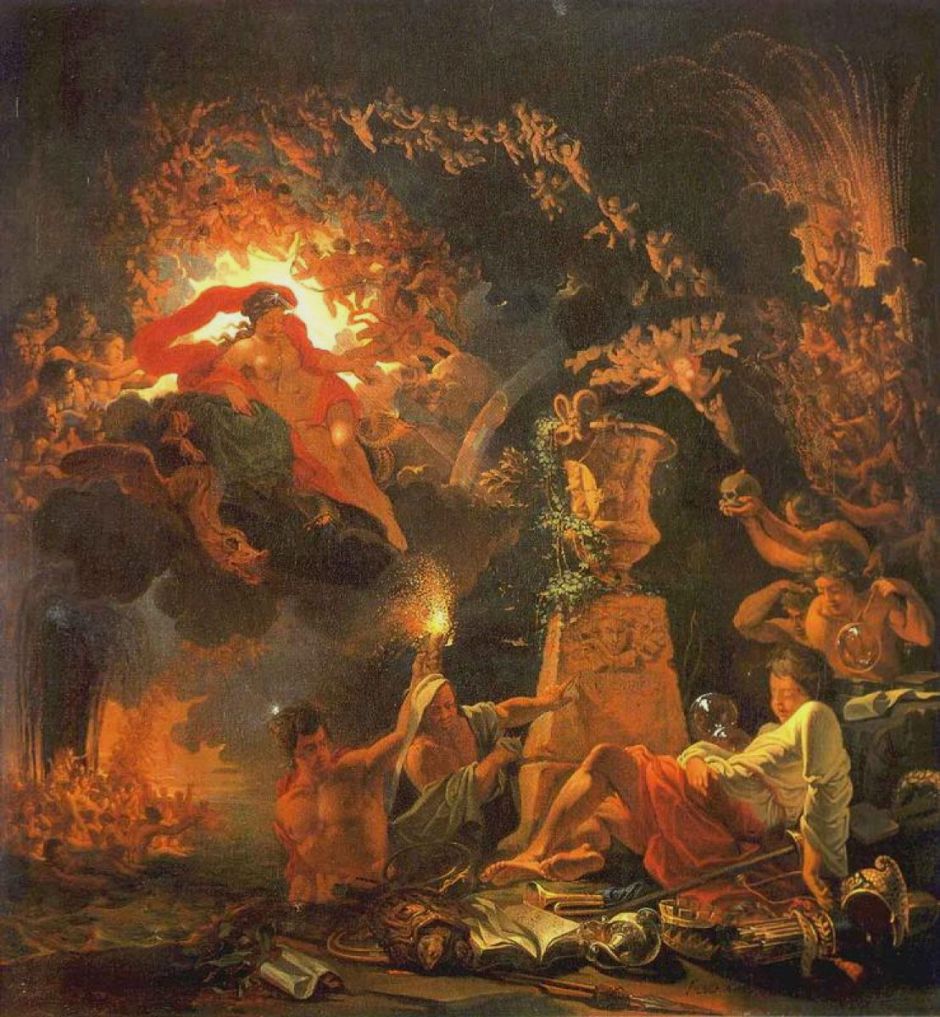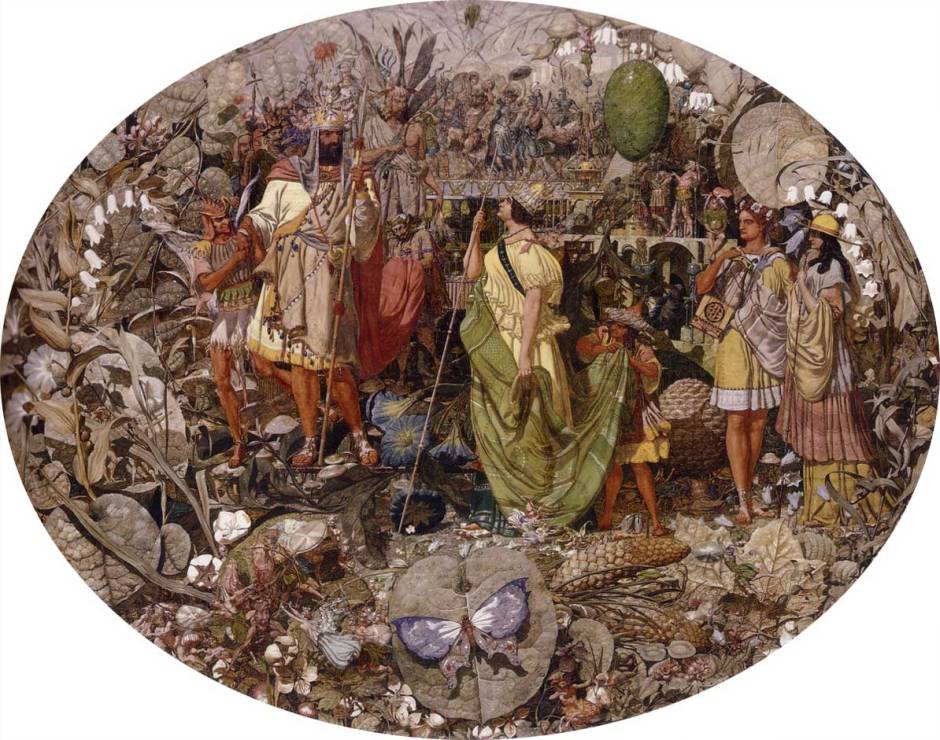Fairies might seem modern, but their origins go right back to the mythology of Persia, although they skipped the classical civilisations of the Mediterranean, appearing again in Celtic and Germanic folklore. Even in English they go under several different names, including fay, fair folk, fairy and faery. They’re most commonly little people, often tiny young women, with butterfly or insect wings and fair faces. They dance through the air in enchanted formations while the grown-ups are asleep below.

Nils Jakob Blommér’s painting of Ängsälvor, Meadow Elves, shows fairies dancing in their diaphanous gowns in a meadow at twilight, representing Spring in his cycle of seasons. The distant buildings have been identified as Gripsholm Castle, which is to the west of Stockholm and was built in the sixteenth century for the Swedish crown.
Although best known from the nineteenth century, early paintings of fairies appeared in the Renaissance.

Allegorical Scene looks like one of the more extreme faerie paintings from Victorian Britain, but was painted by Domenicus van Wijnen almost two centuries earlier. A strange collection of objects lies at the foot of a terracotta urn: these include a large tortoise, a shield, an open book, a trumpet, a quiver full of arrows, a spear, and an oil lamp.
At the upper right, hundreds of small putti-like fairies are being ejected from below, arcing over the top of the painting, and coalescing around a goddess lit brightly from behind. Below her is a river, in which large numbers of naked bathers are congregated, and they too appear to rise up into the sky in another stream of figures.

Similar streams, and a jet of sparks and fire from a sphere, appear in van Wijnen’s The Temptation of Saint Anthony. There’s another complex collection of symbols in and around the figures on the ground.
Don’t be confused, though, by Edmund Spenser’s epic The Faerie Queene, published in 1590 and 1596: the term faerie there refers more to an enchanted world of knights and chivalry, rather than our more modern concept.

The closest this comes to fairies is Henry Fuseli’s painting of Prince Arthur and the Fairy Queen from about 1788. This crosses into Arthurian legend in showing Arthur, son of Uther Pendragon, here the bearer of a magic shield which blinds his enemies and turns them to stone.
It was William Shakespeare’s play A Midsummer Night’s Dream, probably written in 1595-96, that made fairies popular in Britain and beyond, and it has inspired many paintings. These first started to appear in number in the late eighteenth century, when Shakespeare’s plays were considered to make British narrative paintings for exhibitions like Boydell’s Shakespeare Gallery. The play was restored in 1840, and then launched a new sub-genre of faery painting.

Richard Dadd’s Puck was exhibited at the Society of British Artists in 1841, accompanied by a quotation from Act 2 Scene 1 of the play:
I do wander every where
Swifter than the moon’s sphere,
And I serve the fairy queen,
To dew her orbs upon the green.
The puck, Robin Goodfellow, is the mischievous sprite sitting on a toadstool, with nude fairies dancing around. In the four corners are figures resembling river gods. This was well received, although one influential critic warned Dadd that he had to be cautious of the boundary of the absurd.

Joseph Noel Paton’s Puck and Fairies, from “A Midsummer Night’s Dream” from about 1850 presents a wonderful collection of grotesquely humorous figures sat around a large toadstool, with a paler and naked fairy in the foreground.

Joseph Noel Paton’s The Quarrel of Oberon and Titania (1849) is an elaborate fantasy work typical of faery painting. The changeling, the root of the quarrel, is hiding behind Queen Titania, as she argues with the king.

Shortly afterwards, Richard Dadd, painting during his confinement in London’s Bethlem hospital for the mentally ill, made one of his few oil paintings, of Contradiction: Oberon and Titania (1854-8). This develops his early faerie paintings into a new and unique style, and was painted for the hospital’s first resident Physician-Superintendent, William Charles Hood.
There’s hardly a square millimetre of canvas into which Dadd hasn’t squeezed yet another curious detail. Like other great imaginative painters before, Dadd’s dense details dart about in scale: there are tiny figures next to huge leaves and butterflies, and towards the top of the tondo these distortions of scale generate an exaggerated feeling of perspective.
The contradiction of the title refers to the conflict between Oberon and Titania over the changeling child. Titania (inevitably somewhat masculine) stands just to the right of centre, the boy bearing her skirts. To the left of centre is the bearded figure of Oberon, an elfin lad holding him back by his right arm. At the right are Helena and Demetrius, their love remaining unrequited.
Beyond those central figures is an overwhelming mass of detail, miniature scenes and stories involving hundreds of extras, flowers (including the ‘Morning Glory’ convulvulus at the feet of Titania), leaves, an ornate Swallowtail butterfly, a floating jade egg, fungi, and far more. Descriptors like hallucinatory and surreal spring to mind, and have been used in accounts of this remarkable painting.

Dadd’s earlier Titania Sleeping from about 1841 is another elaborate example of faery painting with its intricately detailed human-like creatures. The naked queen has just fallen asleep at the mouth of a grotto. Framing that scene are toadstools, morning glory flowers, and an arch of bats.

Robert Huskisson’s The Midsummer Night’s Fairies (1847) shows a simpler version of a similar scene.

